| Article ID | Journal | Published Year | Pages | File Type |
|---|---|---|---|---|
| 6289751 | International Journal of Food Microbiology | 2016 | 6 Pages |
â¢NaCl reduces putrescine accumulation in a cheese model.â¢NaCl inhibits the growth of putrescine-producing L. lactis.â¢NaCl inhibits the transcription of the putrescine biosynthesis genes.â¢NaCl does not affect the expression of the aguR regulatory gene.
The reduction of NaCl in food is a public health priority; high NaCl intakes have been associated with serious health problems. However, it is reported that reducing the NaCl content of cheeses may lead to an increase in the content of biogenic amines (BAs). The present work examines the effect of NaCl on the accumulation of putrescine (one of the BAs often detected at high concentration in cheese) in experimental Cabrales-like cheeses containing Lactococcus lactis subsp. cremoris CECT 8666, a dairy strain that catabolises agmatine to putrescine via the agmatine deiminase (AGDI) pathway. The genes responsible for this pathway are grouped in the AGDI cluster. This comprises a regulatory gene (aguR) (transcribed independently), followed by the catabolic genes that together form an operon (aguBDAC). Reducing the NaCl concentration of the cheese led to increased putrescine accumulation. In contrast, increasing the NaCl concentration of both pH-uncontrolled and pH-controlled (pH 6) cultures of L. lactis subsp. cremoris CECT 8666 significantly inhibited its growth and the production of putrescine. Such production appeared to be inhibited via a reduction in the transcription of the aguBDAC operon; no effect on the transcription of aguR was recorded. The present results suggest that low-sodium cheeses are at risk of accumulating higher concentrations of putrescine.
